Hong Kong’s film industry dominated South East Asian markets for the latter half of the twentieth century. 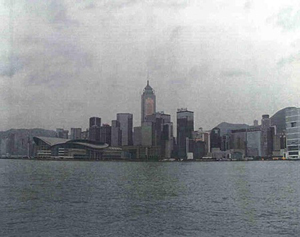 Local productions began declining, however, in the “high anxiety” of the countdown to the “return” of the British colonial city-state to Mainland China in 1997. But when the “handover” had come and gone, expected draconian restrictions failed to materialize. The subsequent Asian financial melt-down did not deter American investors from plans to expand their regional operations; Hollywood “got in” as Hong Kong filmmaking was sinking from the region’s economic contraction. Whereas Hong Kong in the 1990s had been abuzz about which directors and actors might follow John Woo and Chow Yun-fat to Hollywood, more recent speculation has revolved around which companies would open offices alongside those of Columbia (owned by Sony of Japan), Miramax (owned by Disney), 20th Century Fox, and Warner Brothers already operating there.
Local productions began declining, however, in the “high anxiety” of the countdown to the “return” of the British colonial city-state to Mainland China in 1997. But when the “handover” had come and gone, expected draconian restrictions failed to materialize. The subsequent Asian financial melt-down did not deter American investors from plans to expand their regional operations; Hollywood “got in” as Hong Kong filmmaking was sinking from the region’s economic contraction. Whereas Hong Kong in the 1990s had been abuzz about which directors and actors might follow John Woo and Chow Yun-fat to Hollywood, more recent speculation has revolved around which companies would open offices alongside those of Columbia (owned by Sony of Japan), Miramax (owned by Disney), 20th Century Fox, and Warner Brothers already operating there.
Hollywood movies now dominate Hong Kong theater screens that used to show mostly locally-produced films. Thus, a box office “top ten” once comprised of eight Hong Kong and two Hollywood flicks has been turned upside down (with some South Korean films — the next new wave — thrown in from time to time). Local film production levels remains far below the late 1980s and early 1990s heyday when Hong Kong cinema began attracting global attention. Financial investments largely — if not exclusively — dominated by U.S. transnational interests are changing the face of Hong Kong film’s political economy. New (or rather deepening) relations portend the transformation of “national” cinema — to the extent that Hong Kong had such — into “international” cinema under Hollywood’s ever-tighter grip (consider the Koreans who are rapidly selling their film rights to U.S. companies).
Many Hong Kong filmmakers had looked towards the post-1997 day when the People’s Republic would consider their films domestic productions, thus, no longer subject to restrictions limiting entry of foreign films to 20 per year. (Of all its industries, China’s film industry has been the most resistant to “market reforms.”) Those constraints were lifted in 2004, and about 150 Hong Kong movies were screened on the Mainland (most of which were several years old). Meanwhile, US companies have hoped to use their economic clout in co-ventures with Hong Kong partners who have working relations on the Mainland. For example, Columbia Pictures’ Asian operation has invested heavily in Mainland China’s film industry infrastructure in recent years. But something more than increased US investment in Asian films is going on. Hong Kong “stars” — both directors and actors — have gained international popularity and crossed over into western mainstream markets. 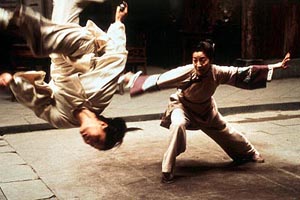 So here’s one possible future: Crouching Tiger, Hidden Dragon — with its Taiwanese director (who has a Hollywood track record), a well-known Hong Kong cast and action director, American and Asian screenwriters, Mainland locations, and western and Asian financing.
So here’s one possible future: Crouching Tiger, Hidden Dragon — with its Taiwanese director (who has a Hollywood track record), a well-known Hong Kong cast and action director, American and Asian screenwriters, Mainland locations, and western and Asian financing.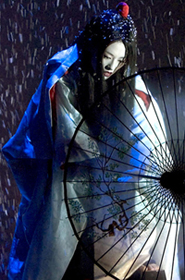 Throw in “oriental exotica” — Zhang Ziyi, star of Chicago director Rob Marshall’s soon-to-be released Memoirs of a Geisha, has been “the babe” for several years — and the profitable multinational scenario plays itself out: western (especially U. S.) audiences flocking to see Hollywood-Hong Kong-Chinese “blockbusters” that have guaranteed access to PRC theaters (perhaps a word of caution: Tiger’s reception in Asia was generally mediocre; audiences had seen such films many times before).
Throw in “oriental exotica” — Zhang Ziyi, star of Chicago director Rob Marshall’s soon-to-be released Memoirs of a Geisha, has been “the babe” for several years — and the profitable multinational scenario plays itself out: western (especially U. S.) audiences flocking to see Hollywood-Hong Kong-Chinese “blockbusters” that have guaranteed access to PRC theaters (perhaps a word of caution: Tiger’s reception in Asia was generally mediocre; audiences had seen such films many times before).
Hong Kong-Hollywood (or Asian-Hollywood) crossover potential remains an open question; some recent co-productions, absent big names like Chan, Chow, Li, and Yeoh that western audiences now recognize, did not get widespread release. Further, Hollywood studios hold onto Hong Kong successes for which they buy distribution rights — to the films’ detriment. 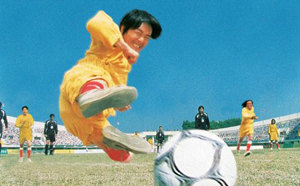 Case in Point One: Shaolin Soccer, Stephen Chiau’s kung fu comedy, the largest-grossing Hong Kong film ever prior to his 2005 Kung Fu Hustle. Miramax sat on the film for three years during which time it cut 25 minutes and added English-language dubbing. Much of its potential audience had seen a pirate version by the time the movie appeared on U.S. screens.
Case in Point One: Shaolin Soccer, Stephen Chiau’s kung fu comedy, the largest-grossing Hong Kong film ever prior to his 2005 Kung Fu Hustle. Miramax sat on the film for three years during which time it cut 25 minutes and added English-language dubbing. Much of its potential audience had seen a pirate version by the time the movie appeared on U.S. screens. 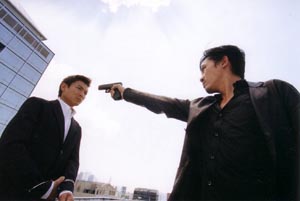 Case in Point Two: Infernal Affairs, a stylish “hit man” flick that is the third highest box office draw in Hong Kong history. In this instance, Miramax’s Harvey Weinstein kept the film on the shelf for almost two years and then allowed it to open in only five theatres in New York City. Did Weinstein’s decision have anything to do with the fact that Martin Scorsese is directing a remake of it, set for release in 2006 (Scorsese’s film is unofficially and, somewhat jokingly, being called “Gangs of Hong Kong”)?
Case in Point Two: Infernal Affairs, a stylish “hit man” flick that is the third highest box office draw in Hong Kong history. In this instance, Miramax’s Harvey Weinstein kept the film on the shelf for almost two years and then allowed it to open in only five theatres in New York City. Did Weinstein’s decision have anything to do with the fact that Martin Scorsese is directing a remake of it, set for release in 2006 (Scorsese’s film is unofficially and, somewhat jokingly, being called “Gangs of Hong Kong”)?
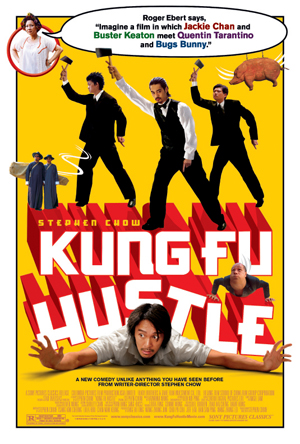 Kung Fu Hustle is a Columbia Pictures (which released the film in the U.S. through its “classics” division) and Bejing Film Studio co-venture that appears to have accomplished for Stephen Chiau what Shaolin Soccer was supposed to have accomplished: global reach. Produced for US$15 million (very costly for Hong Kong’s film industry; comparatively cheap for Hollywood), KFH’s worldwide box-office take is almost US$100 million. The film (already available on DVD) goes beyond Chiau’s previous experimentation with combining computer graphics and live action; it is, in fact, a dramatic departure for a filmmaker who built his career on the use of obscure puns and nonsense language known as “mo-lei-tau” (literally nine follows eight, but nine doesn’t have anything to do with eight, its definitions ranging from “without a shred of evidence” to “at evens and odds”) and local geographic markers. Chiau’s intense use of Cantonese slang and Hong Kong settings was empowering for local audiences, because they “got” the jokes. Moreover, he would reinvest common Cantonese expressions with new meanings, not always translatable into Mandarin or English for viewers reading subtitles.
Kung Fu Hustle is a Columbia Pictures (which released the film in the U.S. through its “classics” division) and Bejing Film Studio co-venture that appears to have accomplished for Stephen Chiau what Shaolin Soccer was supposed to have accomplished: global reach. Produced for US$15 million (very costly for Hong Kong’s film industry; comparatively cheap for Hollywood), KFH’s worldwide box-office take is almost US$100 million. The film (already available on DVD) goes beyond Chiau’s previous experimentation with combining computer graphics and live action; it is, in fact, a dramatic departure for a filmmaker who built his career on the use of obscure puns and nonsense language known as “mo-lei-tau” (literally nine follows eight, but nine doesn’t have anything to do with eight, its definitions ranging from “without a shred of evidence” to “at evens and odds”) and local geographic markers. Chiau’s intense use of Cantonese slang and Hong Kong settings was empowering for local audiences, because they “got” the jokes. Moreover, he would reinvest common Cantonese expressions with new meanings, not always translatable into Mandarin or English for viewers reading subtitles. 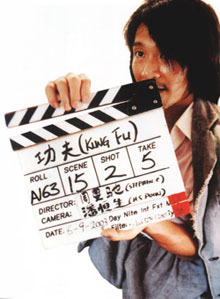 In contrast, Kung Fu Hustle downplays comedic dialogue (mo-lei-tau is pretty much absent), and the film is set in a mythic pre-1949 (hence, pre-PRC) Shanghai. KFH is a ghost of Hong Kong cinema’s former localism and raises questions about whether Hong Kong cinema will be able to retain its distinctiveness in the world marketplace. Changes in the political economy of international cinema may necessitate that Hong Kong films — in production values, storylines, and the language of their dialogue — increasingly anticipate a global audience.
In contrast, Kung Fu Hustle downplays comedic dialogue (mo-lei-tau is pretty much absent), and the film is set in a mythic pre-1949 (hence, pre-PRC) Shanghai. KFH is a ghost of Hong Kong cinema’s former localism and raises questions about whether Hong Kong cinema will be able to retain its distinctiveness in the world marketplace. Changes in the political economy of international cinema may necessitate that Hong Kong films — in production values, storylines, and the language of their dialogue — increasingly anticipate a global audience.
Note: Bruce Lee’s 1973 Enter the Dragon was the first-ever cinematic co-production between Hollywood (Warner Bros.) and Hong Kong (Golden Harvest). Released posthumously, the film was the second-highest U.S. box-office draw for that year.

Michael Hoover is a professor of political science at Seminole Community College. Lisa Odham Stokes is a professor of humanities at Seminole Community College. Hoover and Stokes co-authored City on Fire: Hong Kong Cinema.
